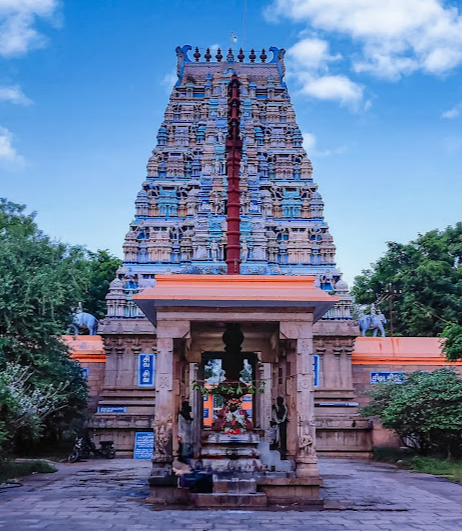In ancient times, this area was known as Darugavanam. The rishis residing here took pride in their superiority, boasting that their wives were the most beautiful and chaste. To teach them a lesson, Lord Shiva and Lord Maha Vishnu devised a plan. Lord Shiva appeared magnificently, carrying a Thiru (pitcher) that captivated all who saw it. Meanwhile, Maha Vishnu transformed into the enchanting Mohini.
Both deities arrived in Darukavanam, where the rishis were immediately mesmerized by Mohini's beauty and followed her. Similarly, the rishis, enchanted by Lord Shiva's glory, abandoned their chastity and pursued him. When they realised that their wives had left them for a beggar, the rishis assumed Shiva was a magician and chased him away. However, both Shiva and Mohini refused to leave, resulting in an enraged confrontation with the rishis. Despite their numerous tactics, they could not withstand Lord Shiva, who carried their weapons and animals within his form.
Realizing their error and unable to defeat Shiva, the Maharishis acknowledged the truth and sought forgiveness. Consequently, Lord Shiva became their Guru, manifesting as Mannitharuli and the Swayambu Lingam.
Sthala Puranam:
The name "Parai" refers to the Daruka tree (Streblus asper), as this location was once a forest of parai trees along the banks of the Kaveri River. The deity and the place derive their name from this natural setting.
Sthala Vriksham: The original Parai maram is significant in the temple's lore. The sages residing in Darukavanam, followers of purva-mimamsa, believed that solely performing Vedic rituals would allow them to overpower God. To teach them a lesson, Lord Shiva manifested as Bhikshatanar, a naked mendicant, accompanied by Vishnu in the form of the enchanting Mohini. The sages’ wives were captivated by Bhikshatanar, leading the sages to believe it was due to their wives' infatuation with the mendicant.
In response to their arrogance, the sages unleashed various nefarious creatures—a snake, a tiger, and a rogue elephant. Shiva subdued the snake, wearing it as a necklace, and vanquished the tiger, using its skin as His waistcloth (this is also referenced in the sthala puranam of the Papanasam temple). At Thalayalangadu, He triumphed over ignorance, symbolized by Muyalagan, and at Vazhuvur, He entered the elephant and tore it from the inside out, earning the name Gajasamharar. This series of events humbled the sages and restored their awareness.
This temple is recognized as the origin of the tale of Shiva as Bhikshatanar, who tamed the egos of the sages. The outer prakaram features the sthala vriksham with a Lingam beneath it, marking the spot where Shiva is said to have emerged to confront the sages' pride.
Interestingly, a similar legend exists at the Chidambaram Natarajar temple, where the setting was a mangrove forest (thillai) instead of the parai forest.
During the Chola period, the temple was referred to as Rajagambheera Valanattu Mazha Nadu Thenkarai Uraiyur Kootrathu Melpilatru Tiruparathurai.
Dakshinamurti is depicted with intricately carved simhathoon pillars adorned with lions. The banyan tree behind Him is detailed in its depiction, while a bas-relief of Shiva performing Urdhva Tandava is found on a pillar in front of the Amman shrine. Another pillar shows Kali dancing, and there’s a carving of a rasi-chakra featuring various zodiac signs. It is believed that devotees who worship the moolavar while standing under their respective zodiac signs will have their wishes fulfilled.
Saint Arunagirinathar has praised Murugan in his revered work, Thiruppugazh, associated with this temple.
The core of the temple dates back to the 6th or 7th century during the early Chola period, with subsequent renovations carried out by the Nagarathar community. The temple showcases exemplary sculptural and architectural elements, possibly added after the initial construction. The artistry of the Chola craftsmen and sthapathis is evident throughout. Ongoing improvements and maintenance have been contributed by the Pandyas, the Vijayanagara dynasty, the Nayaks, and later by the Nagarathar community. Temple inscriptions reference various rulers, including Parantaka Chola, Raja Raja Chola I, Rajendra Chola I, Kulothunga Chola I, Uttama Chola, and Sundara Pandyan, among others.
Administration History :
The temple's administration history reveals that it has been supported by various dynasties over the centuries. It was reconstructed with stone during the Chola period, with significant contributions from kings such as Parantaka I, Rajaraja I, and Rajendra Chozha I. The Nattukottai Nagarathars later took on the responsibility for its upkeep. Inscriptions indicate land and gifts were provided for temple rituals and festivals by several rulers, including the Pandya and Vijayanagara kings. The temple has seen renovations and restorations, particularly in the 20th century, under the guidance of trustees from the Nagarathar community.
